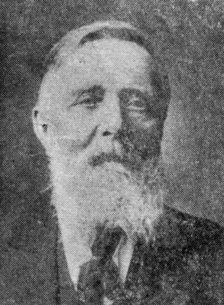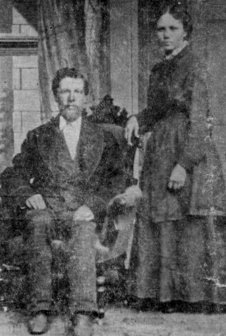Jacob Decker Family Settled
West of Stacyville;
Were Among the First to
Arrive in Union Township
The area west and northwest of Osage, including the Cedar, Rock and St. Ansgar region, was settled mostly by Scandinavians. In the Stacyville territory, Germans were the first to settle - and here we find the Decker family.
Jacob Decker was one of the first to arrive in Union township. He had married Margaret Iinsfield of Rhine river county, Germany. He brought her and his parents, Mr. & Mrs. John George Decker, to Mitchell county, settling west of Stacyville.
Jacobís father was born in Germany on November 12, 1804. Jacobís mother, Anna Mary Decker, was also born in Germany, on November 16, 1808. They lived with their son and daughter-in-law until their death on March 28, 1887 and July 7, 1885, respectively.
Had Two Neighbors
The Deckersí only close neighbors in Union township were Joe Scott, who lived east of them and Sam Woolworth, who lived south of the Decker property. Woolworth owned the first log house in the neighborhood.
The Deckers were attracted to this particular tract of land because of its naturally flat formation. They liked prairie land. Their first house was a temporary one, as they couldnít locate water in the immediate vicinity. Moving farther east, however, they struck a good well and here they built their permanent home.
The original house was built mostly of hand-hewn logs. It has been changed through the years to fit the needs of the family. All 11 children of Jacob and Margaret Decker were born in that house, as were all the children of the next two generations.
Went to McGregor
Deckerís crops, like many other pioneersí, had to be taken to McGregor, 90 miles away, to be sold. Trips were made once a year by oxen.
Deckerís team had a stubborn streak and wouldnít cross a stream of water with a loaded wagon. Decker would have to unhitch the load and drive the oxen across the stream. Then he would go back, unload the wagon, and drive it across. He would return time and time again to the far bank to carry the bags of feed or grain across the stream himself.
Since there were few bridges between here and McGregor, this process was repeated often. For all his work, he was often forced to return home with scarcely enough supplies to last the family through the winter.
Promoted Presbyterian Church
One of the first religious meetings in the community was at the Decker home. Jacob donated land for the Union Presbyterian church and parsonage. He even hauled the lumber for the building from Lyle, MN. The church was finished in 1874. Prior to that, worship services were held in the schoolhouse.
Originally, the road from Stacyville to the Decker farm went on an angle all the way to Lyle. It began as a stage coach road, running diagonally across the prairie. All but one mile of the road has been straightened now.
A round ornament found in the center of what is now the Deckerís kitchen, was originally painted red, white and blue. It is about 4 feet across and is made of plaster of paris. Many such ornaments in other old homes were made of wood.
Jacob Decker died on March 12, 1900 and his wife,
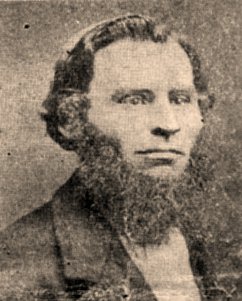
| Jacob Decker
Jacob was the first to arrive in Union township. He claimed land west
of Stacyville. He died on March 12, 1900.
|
Margaret, died on July 15, 1923.
George J. Decker remained on the family farm, buying it from his parents in 1889. He installed the first electricity on the far. This was a 32-vvolt plant. Rural electrification brought real power to the farm in 1939. He also had one of the first three silos in the county. It was used for nearly 30 years before it was torn down.
George Decker married Mary Spuhler in 1888. They had seven children, four of whom are still living. These included Mrs. Fred Pacey and Mrs. Elmer Morische of Osage; Mrs. Maynard Laetsler of Joliet, Illinois; and Bert Decker, who is the present owner of the family farm.
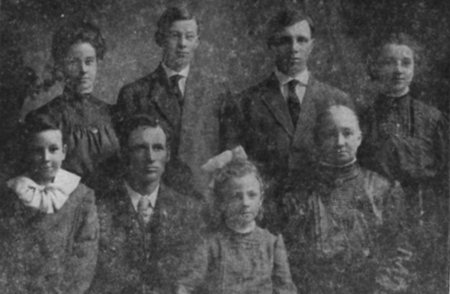
| Decker Family
This was the George Decker family around 1910.
Front row, left to right: Bert Decker, George Decker, Edith (Mrs. Maynard Leatsler), and Mary (Mrs. George Decker).
Back row, left to right: Martha (Mrs. Fred Pacey), Reuben Decker, Ralph Decker, and Stella (Mrs. Elmer Morische)
Larger version
|
Bert was born on the farm on May 10, 1903. He began
farming the land for himself in 1921, when he was 18 years old.
He married Grace Haugen of Osage on Christmas day in 1923,
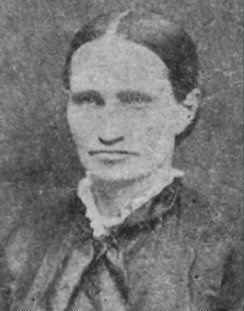
|
Margaret Einsfield Decker
Mrs. Decker married Jacob when they lived
in Germany. |
at the Union Presbyterian church. Their three children - Darrell of San Diego, Lester of osgae, and Mary Helen (Mrs. E. Wells Hubbard) of Tokyo, Japan - were born in the Decker house. All three of Bertís children graduated from the Osage high school, as did Bert and his wife.
For more than 100 years, the farm has remained in Decker hands. Nineteen members of the family were born there and many of the older generation died there. The farm has housed the old and the new alike.
Jacob was the first to arrive in Union township. He
claimed land west of Stacyville. He died on March 12, 1900.
George was the son of Jacob Decker, who first settled on the Decker farm.
|
